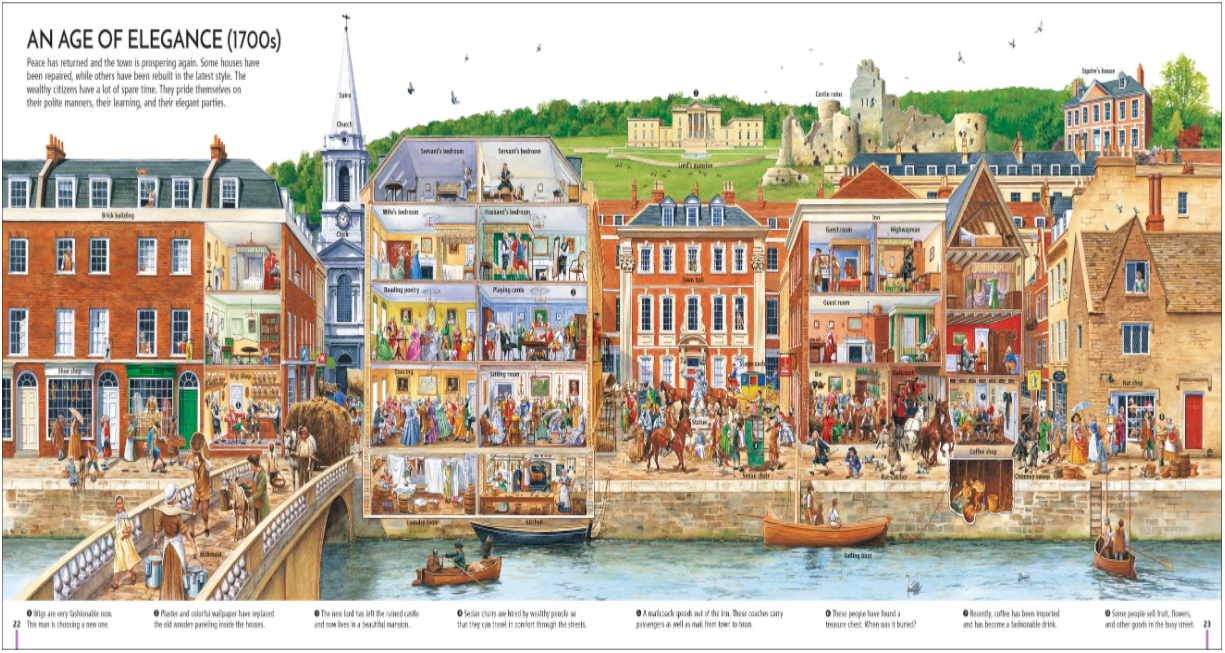Article Post
Jan 31 2022
Illustrating history with artist Steve Noon
Behind the scenes of the beloved children’s book A Street Through Time

In a series of 15 intriguing illustrations, the award-winning A Street Through Time tells the story of human history by exploring a street as it evolves from 10,000 BCE to the present day and then 50 years into the future.
Steve Noon is the award-winning illustrator and artist behind A Street Through Time, as well as a range of other DK books, including A City Through Time, A Child Through Time, and Story of the Titanic. We talked to Steve about his process, and how a book goes from the sketchbook to the bookshelf.
How long does it take you to illustrate each scene? How big are they when you’re creating them?
Each scene from A Street Through Time took about 30 days to create. That would be starting with reading the short written brief from the author to completing the final painted artwork. They varied a little in time, as some scenes were more complex. I painted the scenes about thirty percent larger than they were reproduced, so the completed paintings were about 33 x 90 cm. I always paint illustrations larger than the reproduction size so that once reduced they look crisper. Also, there are many small details in the scenes which would have been very tricky to paint on a smaller scale!
What’s your process before putting pencil to paper?
I'd start with lots of research. The author was very helpful and always supplied me with some information and reference to help me on my way. History has always been a love of mine so being asked to work on this project was very exciting. But often it's not until you need to draw something from history... say a medieval blacksmith's workshop or 16th-century fireplace that you discover you're not entirely sure what it might have looked like. I spent many hours in libraries and second-hand bookshops. I learned a great deal I hadn't fully understood previously, like when windows, chimneys, and wallpaper appeared... I could go on! The whole book had to be planned out before I could start thinking about drawing any scenes. I had to be careful to ensure that each scene followed on from the next and that by the end of the book I still had room to fit everything in. Once the book was planned out, I'd draw a rough sketch of each scene. After that, a very detailed outline pencil drawing and then the final painting. Each stage was shown to the author and the team at DK who would check they were happy with everything and answer any questions I had.
Why do you think illustrating moments in history is so important?
History is really where we all come from. It's what has shaped our everyday lives today, our villages, cities and landscapes. I think it's important to have some understanding of history to appreciate why the world is as it is and how history has shaped us all.
A Street Through Time was first published in 1998. Why do you think this book continues to be popular?
Hopefully, it's something to do with my illustrations! But I think it's also a book you can pick up, enjoy and discover a little bit of history from in an easily accessible format. Maybe it might also spark an interest and you'll want to go off and discover more about the Vikings, the 18th century, another time period, or even how your own street has developed through time.
This new edition of A Street Through Time includes a new spread, “Street of the Future,” which features suggestions from children about what they think our streets will look like in 50 years’ time. Did you enjoy illustrating these futuristic ideas? Do you have a favorite invention?
I'm more used to painting historic scenes so this was quite exciting – I don't think I've ever painted anything futuristic before! As someone who grew up in the 1970s, I can appreciate how some things have changed (a lot), while others seem barely any different. So I guess it may be similar in 50 years' time so some things could look quite familiar, while others might be radically different. I loved the many imaginative and exciting suggestions made by children. I remember wondering when I was a child if we'd all be zooming around the sky in flying cars so I loved that suggestion! Robots becoming increasingly helpful and important in our lives was exciting too. But I think the notion of the street growing, and the many suggestions of how it might be more environmentally aware and sustainable were particularly encouraging to see.
